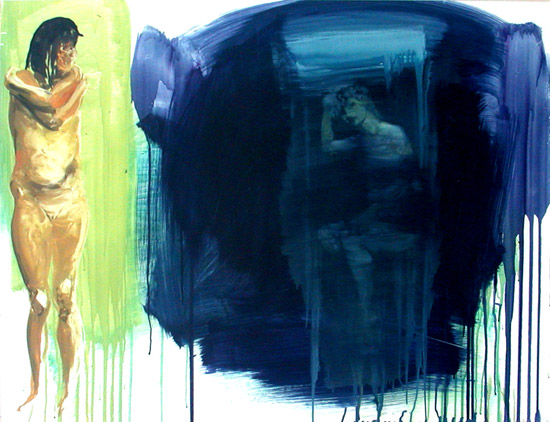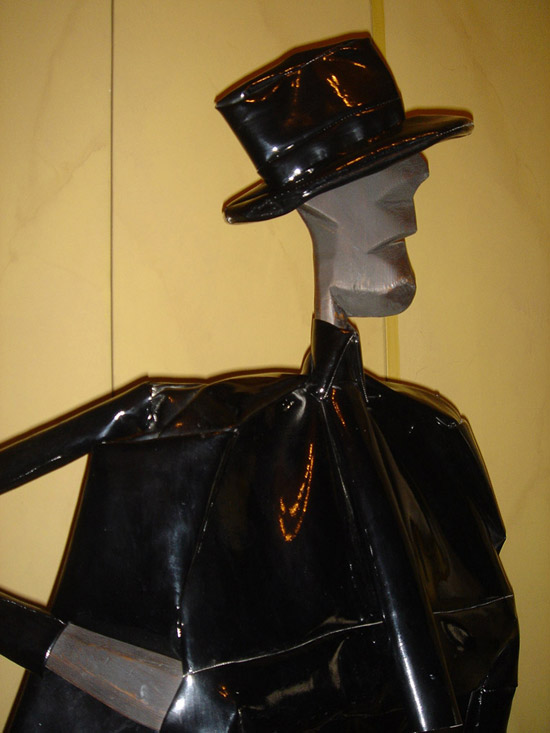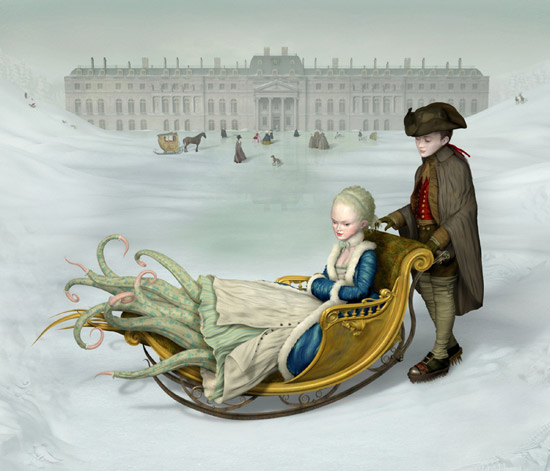In 1959, the great theologian Paul Tillich wrote in his catalogue essay for the "New Images of Man" show at MoMA: “Whenever a new period is conceived in the womb of the preceding period, a new image of man pushes towards the surface and finally breaks through to find its artists.”
Each of the artists in the current show “#NSFW: Bodies,” on view at Vered Gallery in East Hampton through April 7, is grappling with what it means to be human in his or her particular moment in time.
Co-curated by Janet Lehr and Damien A. Roman, “#NSFW: Bodies” (for the uncool like me, NSFW is an acronym for Not Safe For Work) is an aesthetically complex panorama of nudes and portraiture spanning the early 20th century to the present day. Painting, printmaking, photography and sculpture are represented by forms that have been distorted, abstracted, eroticized, mutilated, savaged and cartoonized.
Beginning with Zwei weiblicher Akte, 1919 (Two Female Nudes) by Gustav Klimt, we know we are in for a treat. Could these overtly sexualized figures taking such obvious pleasure in their own sensuality have been created almost 100 years ago? As one might imagine, Klimt’s nudes were labeled pornographic in their day, and three of his paintings were actually destroyed by the Nazis in their purge of degenerate art.
.

"Zwei weiblicher Akte, pl.21" by Gustave Klimt, 1919. Chromolithograph, 22.65 xo 17.75 inches.
.
Thirty years later, the tabloid photojournalist Weegee (the pseudonym for Arthur Fellig), who gained fame for his graphic black and white street photography, began to experiment with distortion through prisms. His rendition of Marilyn Monroe is both recognizable and mutilated; a satire on the way celebratory culture twists and alters the human being.
.

"Composite of 4 Marylin distortions" by Arthur Fellig (Weegee), C. 1950. Silver gelatin print. 13.5x11.5 inches.
.
At about the same time, Pop processor Larry Rivers was also fascinated with depicting and distorting the narrative of contemporary culture. In Double Portrait of Birdie, Rivers offers the same figure in two different poses. The model was the artist’s mother-in-law and, in a provocative move, he chose to invert one of the images and erase her facial features.
.

"Double portrait of birdie" by Larry Rivers, 1954. Graphite on paper, 13.5 x 16.5 inches.
.
One of my favorite pieces in the show is a Willem de Kooning armature for an unrealized sculpture. Untitled 1969 (woman in high heels) is an abstracted rollicking form, a voluptuous, zesty lady prancing in very large high heels.
.

"Untitled (Woman in high heels)" by Willem de Kooning, c.1970. India ink on wood, 36.5 x 42 x 2.25 inches.
.
By the 1970s, performance art and its documentation in photography had pushed the boundaries of human depiction. Images were often the result of recording events but they were also autonomous. In his Photo-Transformation, Lucas Samaras used his body as subject and metaphor of the multi-facetted malleability of the self.
.

"Untitled (Self Transformation)" by Lucas Samaras. 1976 Polaroid, 3 x 3 inches.
.
Fascinated by the way éros (erotic love) transforms the body, photographer Richard Mapplethorpe contorted the facial features of a classic Italian sculpture to resemble those of his lover, the art dealer Sam Wagstaff. In collapsing the two mediums and styles, Mapplethorpe is literally merging his own idea of perfection with that of classical antiquity.
.

"Devil" by Robert Mapplethorpe, 1988. Vintage Silver plate, 24 x 20 inches.
.
Eric Fischl’s mysteriously untitled kromecoat is a glossy, dreamy confection. Two figures who may or may not be the same woman face each other, but seem unaware. While one is an elongated form in pale green hues, the other is curled up and shrouded in darkness. Romantic and evocative, the image is ultimately as inexplicable as life itself.
.

"Untitled" by Eric Fischl, 1988. Oil on kromecoat, 27 x 35 inches.
.
William King’s tragi-comic sculpture, Fred, is a rangy, shiny black vinyl figure. Looming against the wall like a giant hanger, it is as poetic as it is absurd.
.

"Fred" by William King, 1994. Vinyl and wood, 71 x 24 x 21 inches.
.
Jessica Lichtenstein, Colin Christian and Ray Caesar all use the female form to explore deeper themes of fetishism and fantasy in the technological age.
Fascinated by Japanese anime dolls, Lichtenstein creates her own animated worlds, filled with highly sexualized imagery that conflates the pornographic with cartooning. Her landscapes are acrylic “word” sculptures.
.

"XOXO" by Jessica Lichtenstein, 2013. Archival inkjet print mounted on acrylic construction 20 x 54x 3 inches.
.
Inspired by pinups and sci-fi imagery, Colin Christian makes fiberglass simulacrum sculptures that are as close to cartoon realism, to drawing made flesh, as he can achieve. In some cases, Christian’s creations are real models, dressed up as cartoons and then transformed into art.
.

"Batgirl" by Colin Christian, 2014. Fiberglass and mixed media, 35 x 22 x 25 inches.
.
Ray Caesar’s richly textured virtual worlds are aberrant 3D visions, surreal scenes where digitized characters have been transformed into elaborate stories.
Mixing traditional drawing with high tech imagery and scanning—Caesar often embeds representations of his organs into his pictures because he says they take so much out of him—these depictions are personal mythologies. The works are shrines that project and conflate Caesar’s unconscious longing with computerized reality.
.

"Winter" by Ray Caesar, 2013. Archival chromogenic print mounted on Dibond. 48 x 56 inches.
.
Finally, Taylor Pilote’s automotive sculptures evoke the appetite for consumption that is at the core of the contemporary human condition. With slick, sexy finishes that entreat us to touch them and hubcap eyes that blink seductively, they are a synthesis of man and machine.
.

"Seventh Heaven" by Taylor Pilote, 2013. Fiberglass, reproduction tail light and automotive paint, 50 x 20 x 18 inches.
.
Shattered and distorted, dreamed, conjured and manipulated, the work of the artists in “#NSFW: Bodies” explores not just the human form, but the condition of being human. As every generation of artists embraces this search anew, they discover and apply unique materials to their practice. These materials, in turn, interact with and change how we experience life.
What is revealed is a constant reconstruction of identity. For just as the “matter” that is us is continually decaying and reforming, so too is our perception of the nature of what it means to reside within the frames we call our bodies.
BASIC FACTS: “#NSFW: Bodies” remains on view through April 7, 2014. Vered Gallery is located at 68 Park Place (in the Starbuck's Passageway), East Hampton, NY 11937. www.veredart.com.
